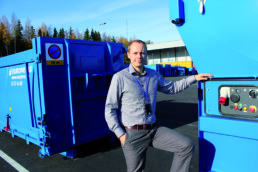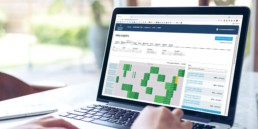15 years of developing smart waste management products
In this series of articles, we present the experts behind the Europress SMART system and share their thoughts regarding how smart waste management is changing the operating environment of the circular economy.
In this article, Executive Vice President Timo Huhtala discusses the development of Europress products over the past 15 years. Huhtala has been at the forefront of the waste management industry by introducing smart features to devices. The development of smart functions at Europress has been closely linked to other product development, ensuring that our equipment works optimally as a whole. In order to develop these advanced products, it has also been necessary to develop production facilities and production operations.
When Huhtala joined Europress as a project manager in 2007, the company’s waste compactors were manufactured in a traditional engineering workshop in Hakkila, Vantaa. The first smart features were only just being developed.
“First fill level monitoring features were already in use. These were quite innovative and ahead of their time even back then,” says Huhtala.

We are currently developing our new Flex product family, which will be an interesting addition to our product offering. The aim is increase capacity by up to 25% with a design that allows for a larger container.
During product development, the mechanical features, hydraulics and electrical engineering of the equipment go hand in hand with its smart features. These smart features in turn include benefits that are directly visible to the user and the waste operator, as well as features that improve the service life and maintainability of the equipment.
“In addition to automatic emptying calls, one of the first improvements enabled by smart technology was the soft turnaround of the ram. This has contributed to extending the service life of all the equipment we have manufactured since 2010. Instead of making a full end stroke, Europress SMART software protects the components by turning back right before the big impact,” Huhtala says, describing one of the initial development steps.
In 2009, Europress moved to new premises at Huhtimo in Kerava, which enabled the development of production automation. The factory currently has two welding robots and a surface treatment robot. These robots have taught Europress a lot about the requirements of automation while also contributing to improvements in product quality. Although Europress has always focused on high quality, automation has taken these demands to a new level.
“Automation has forced us to make even higher quality products, since automated manufacturing requires a higher level of uniformity of components compared to human workers,” says Huhtala.
At the same time, active development work has been done to expand our product offering. During the first decade of 2000, Europress still focused on medium-sized Combi and Duo waste compactors alongside large EPC pre-crushing waste compactors. Over the past decade, these have been joined by Balex waste balers for smaller needs, as well as several specialized waste compactor models for various applications, such as the Mega series with a large feed opening and the VersaMax, which can be easily tailored to the customer’s needs. Timo Huhtala also sheds some light on the future:
“We are currently developing our new Flex product family, which will be an interesting addition to our product offering. The aim is to increase capacity by up to 25% with a design that allows for a larger container.”
We are moving from fill level monitoring to accurate forecasting.
This requires a large fleet of data-accumulating devices, which we have succeeded in creating through long-term work.
The second generation of the Europress SMART system was launched in 2015 with the aim of turning all the data collected from devices into cost-effective services. It has been possible to collect data from SMART waste compactors since 2010, and as the amount of data continues to grow, it can be increasingly utilized to help develop both products and services. At the time of this interview, a total of 10,999 SMART waste compactors have been delivered to customers, so by the time this article is published, Europress will have manufactured more than eleven thousand SMART waste management devices.
“We are moving from fill level monitoring to accurate forecasting. This requires a large fleet of data-accumulating devices, which we have succeeded in creating through long-term work, as well as an artificial intelligence algorithm that is capable of making predictions,” says Huhtala.
Once enough data has been collected, it is possible to develop a wide range of new services that can benefit Europress customers worldwide. For example, our Australian partner has succeeded in building a very effective service package for local customers. In addition to the SMART portal, the SMARTwaste mobile app enables the direct exchange of information between the customer and Europress, which eliminates a lot of bureaucracy and improves the quality of service. According to Huhtala, these innovations have been extremely well received in the market.
“This is a good time to thank all our customers who have wanted to play an active role in developing our services over the years,” Huhtala concludes.




